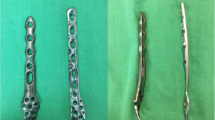Abstract
Background
The authors evaluated results and hardware-related complications after the fixation of Danis-Weber (D-W) types A and B lateral malleolus fractures using a 3.5-mm T-shaped locking compression plate (T-LCP) for distal radius.
Methods
Twenty-six patients with Danis-Weber type A or B lateral malleolar fractures treated between January 2001 and February 2008 were included in this study. Mean age of the patients was 52.6 (28–77) years. All patients were treated using a 3.5-mm T-shaped locking plate for distal radius fractures. The distal fragment was fixed with at least 2 locking screws more. Ankle motion was allowed early after surgery. The authors evaluated serial radiographs, range of motion, skin irritation, and AOFAS scores at final follow-ups.
Results
All fractures united during follow-up. Eight cases were of D-W type A, and 18 were of D-W type B. A mean number of three screws were placed at the distal fragment (2–4). There were 6 cases (23.1%) of implant irritation over the operative site, but no other complications were encountered. At final follow-ups, the AOFAS score of affected ankles was 97.1 ± 4.4.
Conclusion
T-LCP use for type A or B lateral malleolar fractures resulted in low hardware-related complications and produced good results at follow-up.


Similar content being viewed by others
References
Bostman O, Hirvensalo E, Vainionpaa S, Makela A, Vihtonen K, Tormala P, Rokkanen P (1989) Ankle fractures treated using biodegradable internal fixation. Clin Orthop Relat Res 238:195–203
Cimino W, Ichtertz D, Slabaugh P (1991) Early mobilization of ankle fractures after open reduction and internal fixation. Clin Orthop Relat Res 267:152–156
Day GA, Swanson CE, Hulcombe BG (2001) Operative treatment of ankle fractures: a minimum ten-year follow-up. Foot & Ankle International/American Orthopaedic Foot and Ankle Society [and] Swiss Foot and Ankle Society 22(2):102–106
Frigg R (2003) Development of the locking compression plate. Injury 34(Suppl 2):B6–B10
Hirvensalo E (1989) Fracture fixation with biodegradable rods. forty-one cases of severe ankle fractures. Acta Orthop Scand 60(5):601–606
Lamontagne J, Blachut PA, Broekhuyse HM, O’Brien PJ, Meek RN (2002) Surgical treatment of a displaced lateral malleolus fracture: the antiglide technique versus lateral plate fixation. J Orthop Trauma 16(7):498–502
Lee YS, Huang HL, Lo TY, Huang CR (2007) Lateral fixation of AO type-B2 ankle fractures in the elderly: the Knowles pin versus the plate. Int Orthop 31(6):817–821
Tornetta P III, Creevy W (2001) Lag screw only fixation of the lateral malleolus. J Orthop Trauma 15(2):119–121
Miersch D, Wild M, Jungbluth P, Betsch M, Windolf J, Hakimi M (2011) A transcuneiform fracture-dislocation of the midfoot. Foot (Edinb) 21(1):45–47. doi:10.1016/j.foot.2010.10.001
Kim T, Ayturk UM, Haskell A, Miclau T, Puttlitz CM (2007) Fixation of osteoporotic distal fibula fractures: a biomechanical comparison of locking versus conventional plates. J Foot Ankle Surg 46(1):2–6
Snow M, Thompson G, Turner PG (2008) A mechanical comparison of the locking compression plate (LCP) and the low contact-dynamic compression plate (DCP) in an osteoporotic bone model. J Orthop Trauma 22(2):121–125
Sommer C (2003) Locking compression plate. Injury 34(Suppl 2):B4–B5
Jacobsen S, Honnens de Lichtenberg M, Jensen CM, Torholm C (1994) Removal of internal fixation–the effect on patients’ complaints: a study of 66 cases of removal of internal fixation after malleolar fractures. Foot & Ankle International/American Orthopaedic Foot and Ankle Society [and] Swiss Foot and Ankle Society 15(4):170–171
Schepers T, Kieboom B, van Diggele P, Patka P, Van Lieshout EM (2010) Pedobarographic analysis and quality of life after Lisfranc fracture dislocation. Foot & Ankle International/American Orthopaedic Foot and Ankle Society [and] Swiss Foot and Ankle Society 31(10):857–864. doi:10.3113/FAI.2010.0857
Scolaro J, Ahn J, Mehta S (2010) In brief: Lisfranc fracture dislocations. Clin Orthop Relat Res. doi:10.1007/s11999-010-1586-z
Anderson RB, Hunt KJ, McCormick JJ (2010) Management of common sports-related injuries about the foot and ankle. J Am Acad Orthop Surg 18(9):546–556. doi:18/9/546
Minihane KP, Lee C, Ahn C, Zhang LQ, Merk BR (2006) Comparison of lateral locking plate and antiglide plate for fixation of distal fibular fractures in osteoporotic bone: a biomechanical study. J Orthop Trauma 20(8):562–566
Conflict of interest
All the authors emphatically state that there is no conflict of interest between the authors, and no fund or grants were received for the work.
Author information
Authors and Affiliations
Corresponding author
Rights and permissions
About this article
Cite this article
Kim, H.J., Oh, JK., Hwang, JH. et al. The use of T-LCP (locking compression plate) for the treatment of the lateral malleolar fractures. Eur J Orthop Surg Traumatol 23, 233–237 (2013). https://doi.org/10.1007/s00590-012-0952-9
Received:
Accepted:
Published:
Issue Date:
DOI: https://doi.org/10.1007/s00590-012-0952-9




